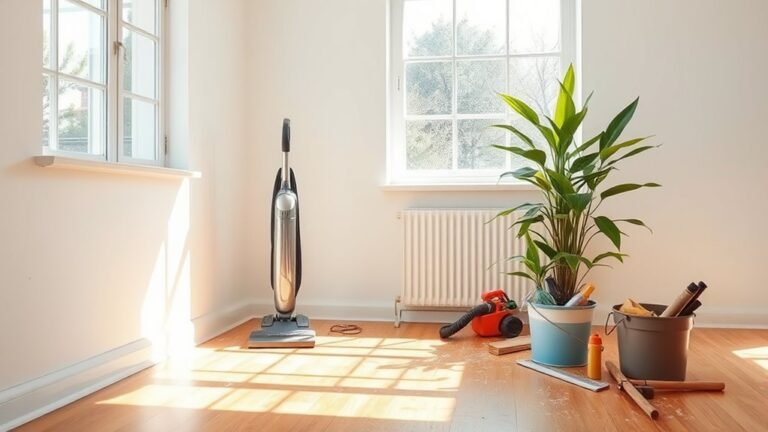Cleaning Tips Before and After Attic
Before cleaning your attic, you should clear out stored items and check floors for safety to create a well-lit workspace. Gather essential tools like a vacuum with a HEPA filter, gloves, and a dust mask. Sort belongings into keep, donate, or dispose groups for easier decluttering. Clean surfaces gently based on material, and make sure vents are clear to promote ventilation. Organizing afterward keeps your attic tidy, and there’s plenty more to make the process even smoother.
Preparing Your Attic for Cleaning

Before you plunge into cleaning your attic, you’ll want to clear out any stored items and create a safe, well-lit workspace. Start by removing clutter to give yourself room to move freely and safely—this is vital for attic safety. Next, check the floorboards and insulation for stability or any hazards that could trip you up. Use a detailed cleaning checklist to keep track of tasks and guarantee nothing gets overlooked. Your checklist might include inspecting for pests, checking ventilation, and noting repairs. Taking these steps sets the stage for a smooth, efficient cleaning session, giving you the freedom to focus on decluttering and revitalizing your attic without worry. Preparing properly makes all the difference in enjoying a safe, stress-free experience.
Essential Tools and Supplies
Before you start cleaning, make sure you’ve gathered the right tools to make the job easier and safer. You’ll need essentials like a sturdy broom, a vacuum with a HEPA filter, and protective gloves. Having the right cleaning supplies on hand will help you tackle dust, cobwebs, and any stubborn grime effectively.
Must-Have Cleaning Tools
Having the right tools can make cleaning your attic much easier and safer. To keep things simple and efficient, start with essential cleaning gadgets like a sturdy broom, a dust mask, and a reliable flashlight. These will help you reach tight corners and protect your lungs from dust. Don’t forget a handheld vacuum to quickly pick up debris without hassle. Organizing bins are a must-have to sort through your belongings as you clean, giving you the freedom to decide what stays, goes, or gets stored neatly. With these tools, you’ll tackle your attic confidently and efficiently, freeing up space and clearing out clutter without feeling overwhelmed. Keep it straightforward, and you’ll enjoy the process more than you expect.
Recommended Cleaning Supplies
To clean your attic effectively, you’ll need a few essential supplies beyond just tools. Start with eco friendly products like biodegradable cleaners and natural disinfectants to keep your space fresh without harsh chemicals. Grab sturdy gloves, dust masks, and protective eyewear to shield yourself from dust and debris. A reliable vacuum with a HEPA filter will help capture fine particles, while microfiber cloths are great for wiping surfaces. Don’t forget a flashlight or headlamp for tight, dim spots. Using cleaning checklists can keep you organized and guarantee no area gets overlooked, giving you the freedom to tackle your attic methodically. With the right supplies, your attic cleanup will be efficient, safe, and environmentally conscious—letting you enjoy a cleaner, healthier space.
Sorting and Decluttering Strategies

Start by sorting your attic items into clear categories like keep, donate, and dispose. This will make deciding what stays and what goes much easier. Remember, donating usable items helps others while clearing space for what truly matters.
Categorize Items Efficiently
Although tackling a cluttered attic can feel overwhelming, categorizing your items efficiently makes the process much more manageable. Start by sorting everything into clear item categories—seasonal decorations, old clothes, tools, and keepsakes. This way, you’ll know exactly where each thing belongs, freeing your mind from chaos. Next, use labeling systems to mark boxes and storage bins clearly. Simple labels help you find what you need fast and prevent future messes. When you commit to this organized approach, your attic transforms from a stress zone into a space that serves you. By categorizing smartly now, you’re creating freedom for yourself later, making upkeep effortless and giving you peace of mind every time you step up there.
Dispose and Donate
Once you’ve sorted your attic items, deciding what to dispose of or donate becomes much easier. You can liberate yourself from clutter by separating what no longer serves you. For items in good condition, consider heading to local donation centers where your belongings can find new life and help others. This not only clears your space but also supports your community. For things that can’t be donated, explore recycling options to minimize waste and reduce your environmental impact. Don’t hesitate to responsibly dispose of broken or unusable items—holding onto them only weighs you down. Embrace this opportunity to create freedom in your home by letting go thoughtfully, making room for what truly matters and feels right for your life moving forward.
Cleaning Techniques for Different Surfaces
Different surfaces in your attic require specific cleaning methods to avoid damage and guarantee thorough results. For wood surfaces, start by dusting gently with a microfiber cloth to remove loose dirt. Avoid soaking the wood; instead, use a slightly damp cloth with mild soap if necessary. This prevents warping or mold growth. When tackling metal surfaces, you can be a bit more vigorous. Use a damp cloth with a mild detergent to wipe away grime, then dry immediately to prevent rust. For stubborn spots, a soft brush or steel wool can help, but be cautious not to scratch. By treating each surface with care, you’ll preserve the integrity of your attic’s materials, making your cleaning efficient and freeing you from future hassles.
Ensuring Proper Attic Ventilation

Taking care of your attic’s surfaces is important, but so is making sure the space stays well-ventilated. Proper ventilation prevents moisture buildup, reduces heat, and stops mold from taking hold. To meet ventilation requirements, you’ll want a balanced system with intake vents near the eaves and exhaust vents closer to the roof peak. This setup promotes continuous air circulation, helping your attic breathe freely. Without it, you risk damage to insulation and wood structures. Check that vents aren’t blocked by debris or insulation during your cleaning routine. If your attic lacks enough vents, consider adding more to improve airflow. By ensuring proper attic ventilation, you maintain a healthier home environment and extend your attic’s lifespan—giving you the freedom to enjoy your space without worries.
Organizing and Maintaining Your Attic Space
Although the attic is often overlooked, organizing and maintaining this space can make a big difference in how you use it. You’ll find that effective attic storage not only frees up clutter elsewhere but also gives you more control over your belongings. Start by sorting items into categories and using clear bins for easy access. Utilize vertical space with shelves or hooks to maximize space optimization without sacrificing accessibility. Regularly check for dust, pests, or moisture to keep everything in good shape. By keeping your attic tidy and well-maintained, you create a functional, stress-free area that supports your lifestyle and gives you the freedom to store what matters most efficiently. Consistent upkeep guarantees your attic remains a valuable, organized extension of your home.
Frequently Asked Questions
How Often Should I Schedule Professional Attic Inspections?
You should schedule professional attic inspections at least once a year to keep your attic maintenance on track. Regular inspection frequency helps spot issues early, like leaks or pests, so you can avoid costly repairs and maintain your home’s freedom from unexpected damage. If your area experiences harsh weather, consider twice-yearly inspections. Staying proactive with inspections means you’re free to enjoy peace of mind without worrying about hidden attic problems.
Can Attic Cleaning Reduce Energy Bills?
Absolutely, attic cleaning can help reduce your energy bills by improving energy efficiency. When you clear out dust, debris, and old insulation, you create a better environment for insulation upgrades, which keep your home warmer in winter and cooler in summer. This means your HVAC system doesn’t have to work as hard, saving you money and giving you more freedom to enjoy life without worrying about high utility costs.
What Are Common Allergens Found in Attics?
When you explore your attic, you’ll often find common allergens like dust mites and mold spores lurking. These tiny invaders can trigger sneezing, coughing, or itchy eyes, limiting your freedom to enjoy a healthy home. Dust mites thrive in warm, dusty environments, while mold spores flourish in damp, poorly ventilated spaces. Knowing this helps you take control, so you can breathe easy and feel free without unwanted allergies holding you back.
Is It Safe to Store Food in the Attic?
Did you know over 60% of attic temperatures can soar above 120°F in summer? When it comes to food storage, that’s a red flag. Attic safety isn’t just about avoiding pests; extreme heat and humidity can spoil your food or cause packaging to degrade. So, if you want to keep your freedom to snack safely, it’s best to avoid storing perishables up there and opt for a cooler, more controlled space instead.
How Do Pests Typically Enter the Attic?
Pests usually enter your attic through common attic entry points like gaps around vents, roof seams, or damaged shingles. They can also sneak in through openings near chimneys or loose soffits. To keep your space critter-free, focus on pest prevention techniques like sealing these gaps and installing screens over vents. By taking these steps, you’ll enjoy the freedom of a clean, secure attic without unwanted visitors crashing your space.






